Abstract
Stools from 109 patients with inflammatory bowel disease (13.4%) contained Clostridium difficile or its toxin, an incidence similar to the stools of 99 control patients with diarrhoea (11.9%), but significantly higher than the stools of 77 control patients with a normal bowel habit (1.4%). Sixty-six per cent of the diarrhoea controls, but only 11% of the inflammatory bowel disease patients, reported recent antibiotic use: however, 67% of inflammatory bowel disease patients were taking sulphasalazine. The presence of Cl difficile in the stool was not related to the clinical assessment of inflammatory bowel disease relapse, but it was related to hospital admission. During the one year study, 31 of the 109 patients (28%) with inflammatory bowel disease had one or more stool samples that were positive for Cl difficile.
Full text
PDF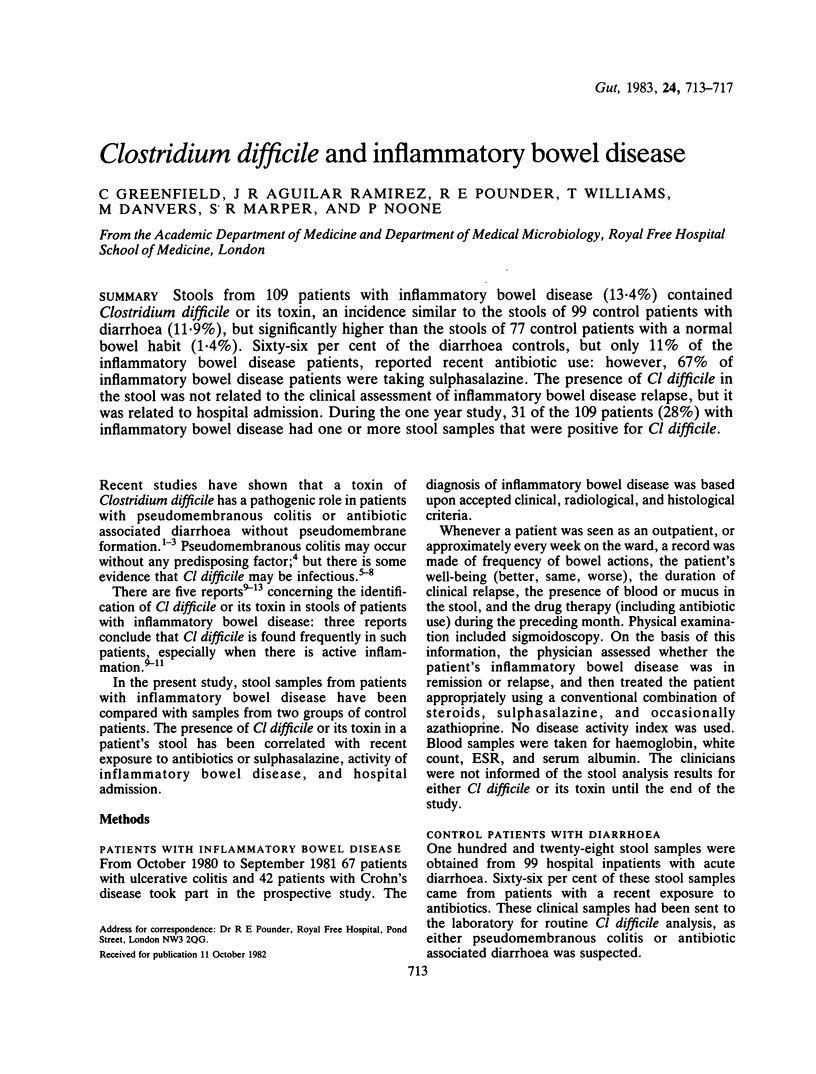
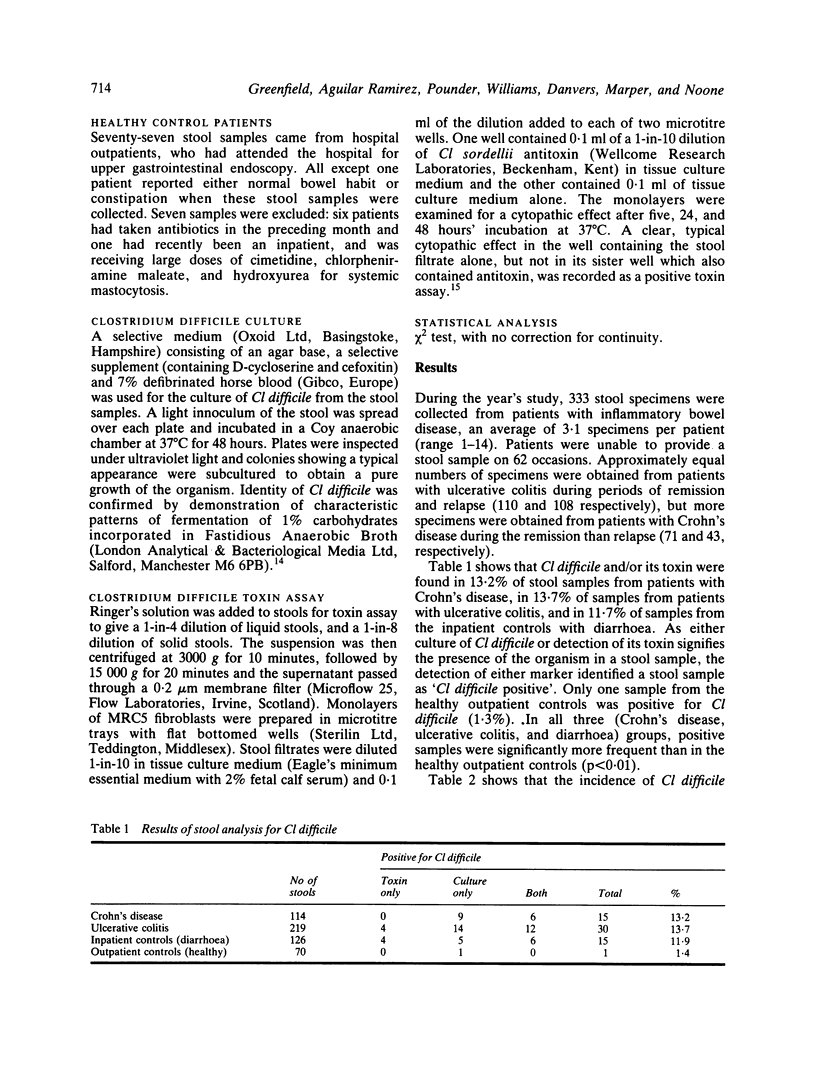
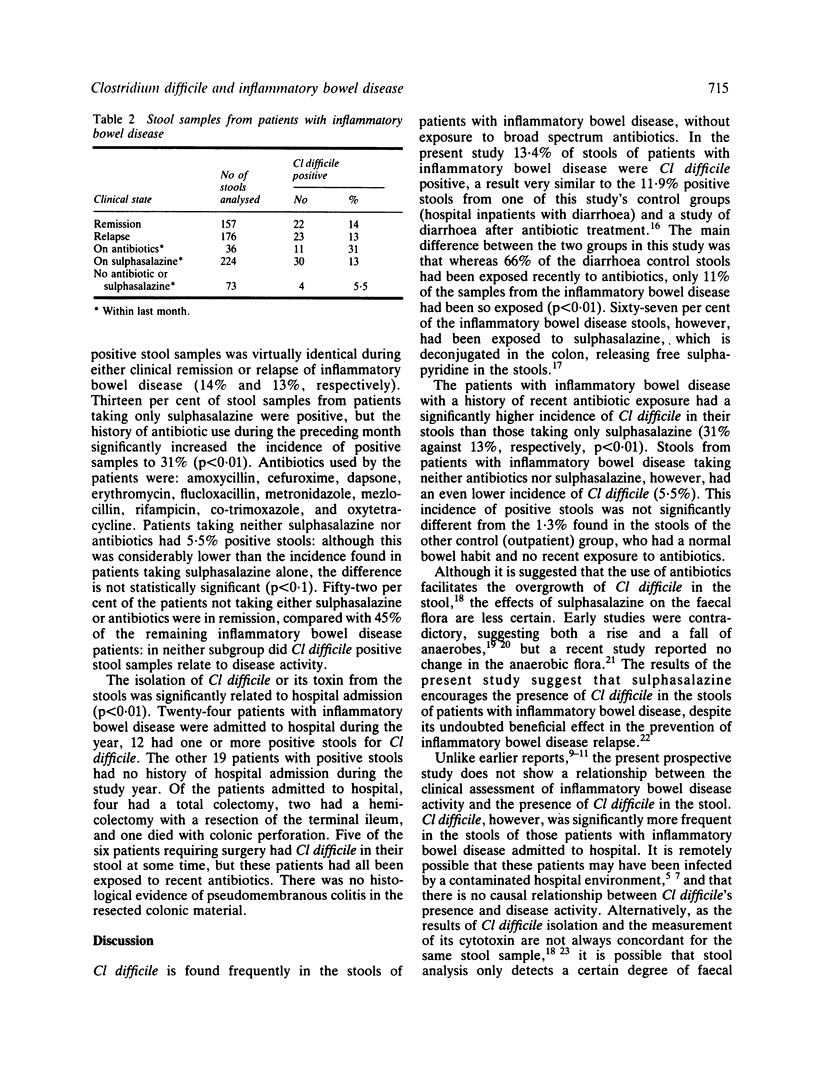
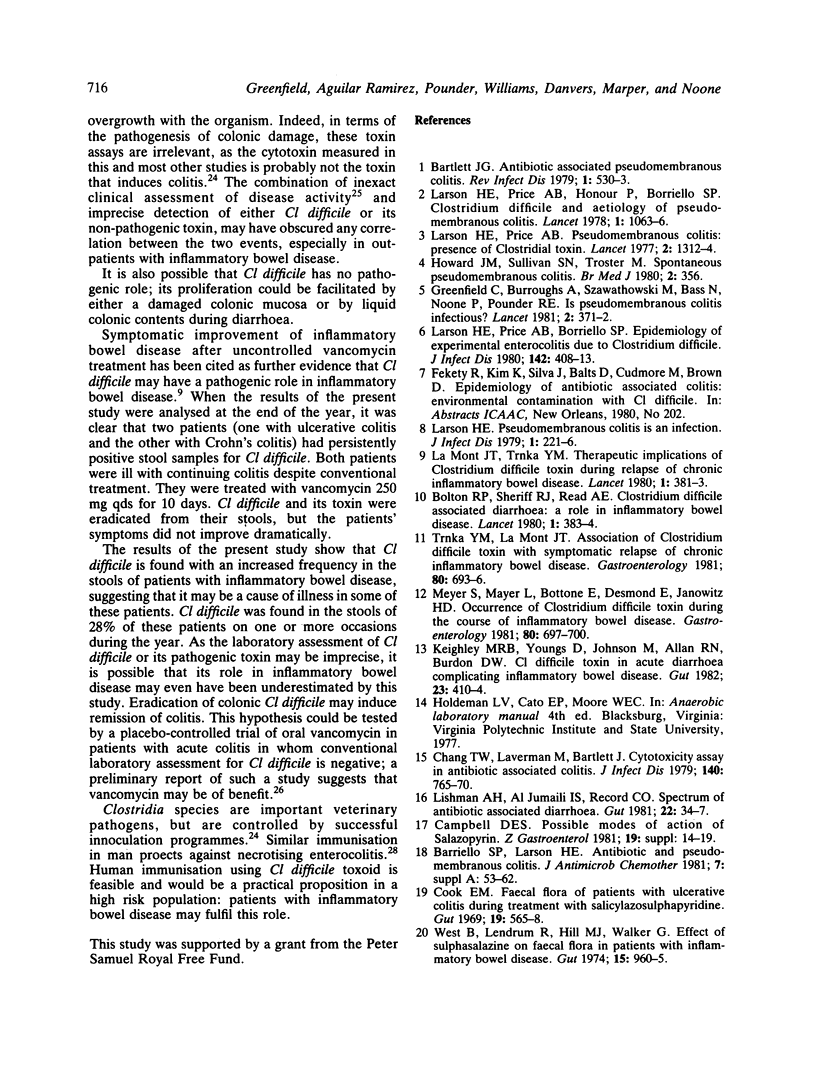
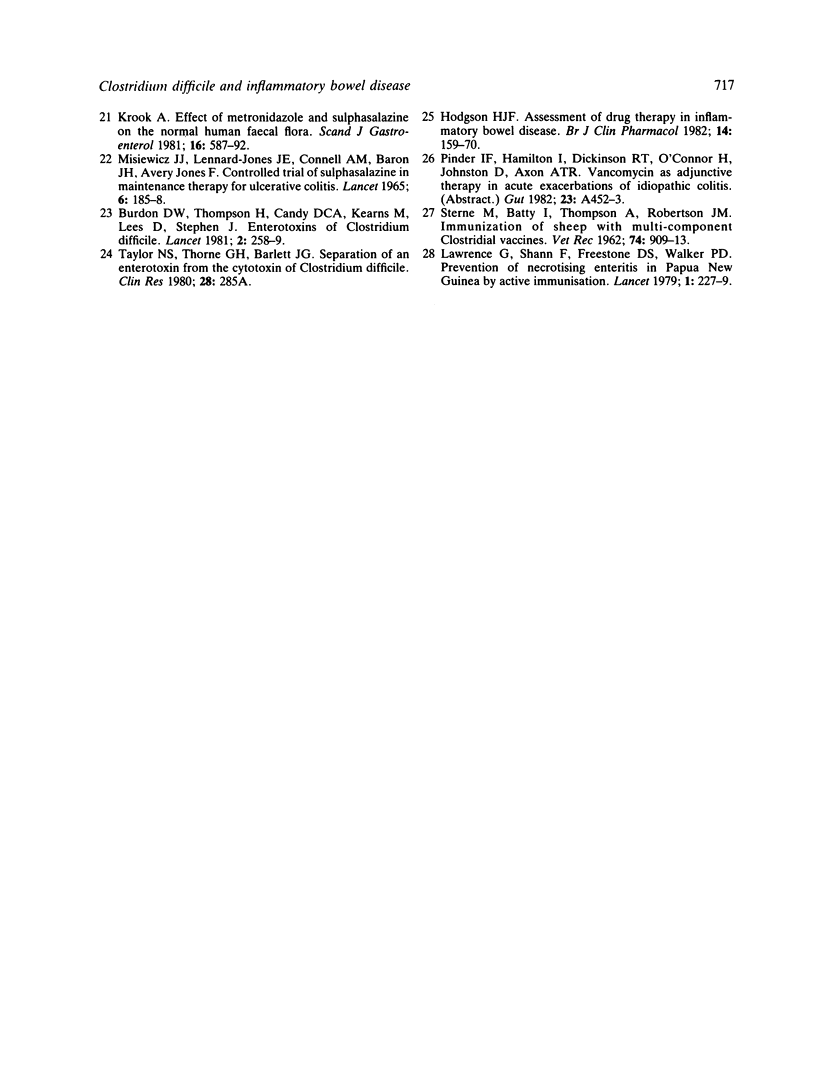
Selected References
These references are in PubMed. This may not be the complete list of references from this article.
- Bartlett J. G. Antibiotic-associated pseudomembranous colitis. Rev Infect Dis. 1979 May-Jun;1(3):530–539. doi: 10.1093/clinids/1.3.530. [DOI] [PubMed] [Google Scholar]
- Bolton R. P., Sherriff R. J., Read A. E. Clostridium difficile associated diarrhoea: a role in inflammatory bowel disease? Lancet. 1980 Feb 23;1(8165):383–384. doi: 10.1016/s0140-6736(80)90940-x. [DOI] [PubMed] [Google Scholar]
- Burdon D. W., Thompson H., Candy D. C., Kearns M., Lees D., Stephen J. Enterotoxin(s) of Clostridium difficile. Lancet. 1981 Aug 1;2(8240):258–259. doi: 10.1016/s0140-6736(81)90507-9. [DOI] [PubMed] [Google Scholar]
- Chang T. W., Lauermann M., Bartlett J. G. Cytotoxicity assay in antibiotic-associated colitis. J Infect Dis. 1979 Nov;140(5):765–770. doi: 10.1093/infdis/140.5.765. [DOI] [PubMed] [Google Scholar]
- Cooke E. M. Faecal flora of patients with ulcerative colitis during treatment with salicylazosulphapyridine. Gut. 1969 Jul;10(7):565–568. doi: 10.1136/gut.10.7.565. [DOI] [PMC free article] [PubMed] [Google Scholar]
- Greenfield C., Burroughs A., Szawathowski M., Bass N., Noone P., Pounder R. Is pseudomembranous colitis infectious? Lancet. 1981 Feb 14;1(8216):371–372. doi: 10.1016/s0140-6736(81)91683-4. [DOI] [PubMed] [Google Scholar]
- Hodgson H. J. Assessment of drug therapy in inflammatory bowel disease. Br J Clin Pharmacol. 1982 Aug;14(2):159–170. doi: 10.1111/j.1365-2125.1982.tb01957.x. [DOI] [PMC free article] [PubMed] [Google Scholar]
- Howard J. M., Sullivan S. N., Troster M. Spontaneous pseudomembranous colitis. Br Med J. 1980 Aug 2;281(6236):356–356. doi: 10.1136/bmj.281.6236.356. [DOI] [PMC free article] [PubMed] [Google Scholar]
- Keighley M. R., Youngs D., Johnson M., Allan R. N., Burdon D. W. Clostridium difficile toxin in acute diarrhoea complicating inflammatory bowel disease. Gut. 1982 May;23(5):410–414. doi: 10.1136/gut.23.5.410. [DOI] [PMC free article] [PubMed] [Google Scholar]
- Krook A. Effect of metronidazole and sulfasalazine on the normal human faecal flora. Scand J Gastroenterol. 1981;16(5):587–592. doi: 10.3109/00365528109182016. [DOI] [PubMed] [Google Scholar]
- LaMont J. T., Trnka Y. M. Therapeutic implications of Clostridium difficile toxin during relapse of chronic inflammatory bowel disease. Lancet. 1980 Feb 23;1(8165):381–383. doi: 10.1016/s0140-6736(80)90939-3. [DOI] [PubMed] [Google Scholar]
- Larson H. E., Price A. B., Borriello S. P. Epidemiology of experimental enterocecitis due to Clostridium difficile. J Infect Dis. 1980 Sep;142(3):408–413. doi: 10.1093/infdis/142.3.408. [DOI] [PubMed] [Google Scholar]
- Larson H. E., Price A. B., Honour P., Borriello S. P. Clostridium difficile and the aetiology of pseudomembranous colitis. Lancet. 1978 May 20;1(8073):1063–1066. doi: 10.1016/s0140-6736(78)90912-1. [DOI] [PubMed] [Google Scholar]
- Larson H. E., Price A. B. Pseudomembranous colitis: Presence of clostridial toxin. Lancet. 1977 Dec 24;2(8052-8053):1312–1314. doi: 10.1016/s0140-6736(77)90363-4. [DOI] [PubMed] [Google Scholar]
- Lawrence G., Shann F., Freestone D. S., Walker P. D. Prevention of necrotising enteritis in Papua New Guinea by active immunisation. Lancet. 1979 Feb 3;1(8110):227–230. doi: 10.1016/s0140-6736(79)90764-5. [DOI] [PubMed] [Google Scholar]
- Lishman A. H., Al-Jumaili I. J., Record C. O. Spectrum of antibiotic-associated diarrhoea. Gut. 1981 Jan;22(1):34–37. doi: 10.1136/gut.22.1.34. [DOI] [PMC free article] [PubMed] [Google Scholar]
- Meyers S., Mayer L., Bottone E., Desmond E., Janowitz H. D. Occurrence of Clostridium difficile toxin during the course of inflammatory bowel disease. Gastroenterology. 1981 Apr;80(4):697–670. [PubMed] [Google Scholar]
- Trnka Y. M., LaMont J. T. Association of Clostridium difficile toxin with symptomatic relapse of chronic inflammatory bowel disease. Gastroenterology. 1981 Apr;80(4):693–696. [PubMed] [Google Scholar]
- West B., Lendrum R., Hill M. J., Walker G. Effects of sulphasalazine (Salazopyrin) on faecal flora in patients with inflammatory bowel disease. Gut. 1974 Dec;15(12):960–965. doi: 10.1136/gut.15.12.960. [DOI] [PMC free article] [PubMed] [Google Scholar]


